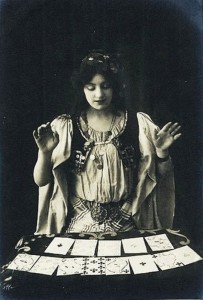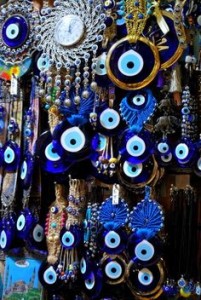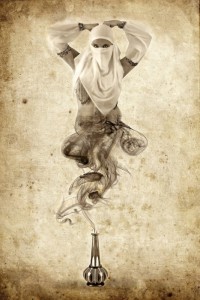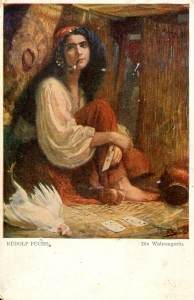Blog 06. Feb 11 2015 The Evil Eye and Vampires: Superstition in the Ottoman World.
The Evil Eye and Vampires: Superstition in the Ottoman World.
In The Embroiderer, both Dimitra and her granddaughter Sophia lived in a world in which superstition played an important role, every ailment or misfortune being put down to the baneful effects of the Evil Eye or to the influence of witchcraft, and even educated classes had difficulty in throwing off the beliefs associated with their nurses’ milk. It would take more than this blog to collect all the folk beliefs and superstitions during the final days of the Ottoman Empire, suffice to say that it crossed all races, religions and sexes but it was the women who attached the greatest significance to it. For them, many of whom led a cloistered existence, every trivial event of the day possessed a significant prophetic of good or evil. In 1912, the year of the outbreak of The First Balkan War, Sophia had reached the pinnacle of her career and La Maison du L’Orient was a fashion house to rival the great houses of Paris. As was the custom, the premises were blessed by the Greek Orthodox Priest, Father Yannakos, and the Muslim Hodja, Abdul Hodja: not to have done so was unthinkable.
It can be argued that at the root of any type of superstition is a belief in magic which is a philosophy to which man resorts to again and again whenever modern gods fail him; in short, when his faith wilts he becomes superstitious. Superstition offers the comforting assurance that it is possible to influence one’s fate for good and evil by will-power reinforced with ritual. Most of all it taps into our deep-seated anxieties and implies an unquestioning assumption that there is a power external to man himself, which is capricious and highly dangerous; a force that must be cajoled and won over to one’s side or, if it is hostile, kept at bay.
All superstitions seem to have the dual purpose of attracting favourable influences and warding off unfavourable ones. The names we give to those influences may be good luck or bad luck and they correspond closely to the good and evil spirits of our ancestors. In her studies of the Turkish people in 1909, Lucy M. J. Garnett sites that there were no laws to interfere with the time-honoured calling of the Witch, and in every part of the Empire, she and her magical powers were held in high esteem. “To the Witch-Wife repair love-sick maidens and jealous wives, childless women and mothers with ailing children and seekers of lost or stolen property. Fortune telling is also largely practiced by the Witch and is performed by means of cards, or a tray of dried beans, coins, beads and other small objects which are manipulated according to some traditional formula. A considerable part of the Witch’s trade consisted in providing love-spells and potions, and occasionally, it may be added, spells of a less innocent nature. Persons believing themselves to be suffering from the effects of a spell, naturally have recourse to the Witch to remove it. Her skill is also resorted to when measures apparently fail to exorcise that most dreaded of all mysterious powers – the Evil Eye.
To protect against the Evil Eye, one could resort to a long list of protective measures; charms consisting of gold coins. Horn-shaped bits of coral, and blue glass, turquoise ornaments, engraved bloodstones and cornelians, cloves of garlic sewn in silk, and other small objects which were tied to the caps or hung around the necks of children, and which also ornamented the headstalls of horses, mules and donkeys; and the horseshoes, boars’ tusks and hares’ heads hung on the walls of houses and other buildings. Blue glass bracelets were worn for the same purpose and when they were broken, as is inevitable with glass, the accident was attributed to the Evil Eye having luckily fallen upon the bracelet and not the wearer. Certain individuals were notorious for casting the Evil Eye, any person or object of which they speak coming to grief in some way or another. Consequently, their neighbours were fearful of offending them. Red-haired women were particularly suspected of possessing such powers, as were people with blue or grey eyes – a rarity in the East.
Besides the Evil Eye, the Ottomans also had to content with Djins and Peris, familiar to many in stories such as Aladdin and his magic lamp from Tales of The Arabian Nights. These supernatural beings were generally thought to haunt ancient buildings and guard buried treasures besides other uncanny beings whose propensities resemble those of goblins and pixies of Western Europe. Some houses were also believed to be haunted by Djins and were often known as Ev-Sahibi – “Lord of the House.” If these were good Djins, they brought all kinds of prosperity to the house, and no matter how idle or extravagant the good wife may be, everything would go well with the household. Ev- Sahibi were said to be clothed in bridal garments edged with tiny bells, the tinkling of which announced their presence in the house. The malevolent Ev-Salibi on the other hand, was known to be mischievous and liable destroy a family’s property besides annoying its members with intolerable nocturnal noises. In common with other magical beings, these Djins had the power to assume any shape they pleased, from that of a shadowy being of enormous proportions , or a beautiful youth or maiden, down to that of a cat or dog or even a broom. According to legend, both the good Djins and Peris who served Allah or God, and the evil Djins – the followers of the Spirit of Darkness – could be both sexes and were believed to have been created before man. One of their properties was to carry off by night the clothes of a human – especially the gala dresses of women – to wear at their nocturnal revels. If such a garment appeared to be losing its freshness, it was concluded that the Djins had taken a fancy to it and the owner would regret not having had it “blessed” by some Holy Man before wearing it.
The holy man, whose breath had acquired a supernatural healing power, was frequently called to attend the sick. After breathing on the head or the afflicted parts of the sufferer accompanied by the placing of hands on his body, he would conclude by leaving a tiny scroll of paper inscribed with holy words for the person to wear for a few days, or order it to be eaten or to be soaked in water and the liquid drunk. Whatever the success – or lack of – nothing could shake the faith of the believer. If they failed, it is from a want of faith on the part of the wearer. In any case, the Holy Man received a fee for his services.
The relics of certain saints were also thought to have healing properties. St Demetrius belongs to a class of Saints termed by the Greeks as Myroblutai – exuding a sweet smell. St Nicholas and St Catherine are also supposed to have exuded an “odoriferous unguent.”
Perhaps the most gruesome of all superstitions was a belief in the existence of Vampires which extended to all races of South-Eastern Europe and which can be traced back to the Chaldean Epic of the third millennium B.C., when Istar in Hades says “I will cause the dead to rise and devour the living”. The vampire is no nebular ghost, but the actual resuscitated body of a man (generally they were of the male sex) who emerges from his grave in the dead of night to roam abroad, revelling in blood. The causes of vampirism varied; the fact either of having perpetrated, or of having been the victim of a crime of murder; having grievously wronged someone who has died resenting the wrong, or having been made the subject of a curse, religious or otherwise. Vampirism was also thought to be hereditary and the unfortunate members shunned by their neighbours. Like a ghost, a vampire must always return to his grave before cockcrow and if bold enough, the neighbours could be found waiting for it with either the Christian Priest or the Muslim Hodja whose various exorcisms often proved to be effective in putting an end to his nocturnal wanderings.
Lucy M.J. Garnett tells of the whole population of Adrianople (Edirne) being thrown into chaos by the reported nightly appearances of a spectre in a part of the town inhabited by both Turks and Greeks. The spectre was represented as a Vurkolak by persons who affirmed that they had seen it lurking in the shadows – a long, lank, cadaverous visage clad in a sheet. The Priest and the Hodja tried in vain for a fortnight to exorcise the wanderer by prayers and incantations until finally, a rumour circulated that the only person possessed of the power of freeing the city was a Turkish djindji , or magician, famous for his influence over apparitions, who lived in a distant town. And who would consequently require a substantial fee for his services. Seven hundred piastres – a hefty sum at the time – was speedily raised by the panic stricken townsfolk , the djindji came and the Vurkolak was put to flight. Had this exorcism proved futile, the people would have had no other option but to proceed by daylight to the grave of the reputed vampire, and either drive a stake through the heart of the undissolving corpse, or disinter and consume it with fire.
Today, superstition still exists in the countries of the former Ottoman Empire, albeit in a watered-down form. In Turkey, the idea that fate is predestined still influences thoughts and actions: if it is their kismet that calamity shall overtake them, overtake them it will. And in both Greece and Turkey, the blue bead to protect against the Evil Eye is everywhere; businesses and new homes are still blessed by the Priest or Hodja, and the reading of coffee grains from an upturned cup of Greek/Turkish coffee is still a favourite pastime in many households.
So what did take place in The Embroiderer on that fateful afternoon in Smyrna, Asia Minor 1865, the impact of which would effect the following generations for years to come.
Excerpt: The Embroiderer. Chapter 3
It was the custom of itinerant vendors to walk through the streets peddling their wares. Selling everything from water, fried food, sweets, sherbets and nuts, to old clothes, threads and lengths of ribbons, the special call of each vendor added a pleasant and lively atmosphere to daily life. A great favourite of both children and adults alike, was the storyteller. Whenever Ali the Hunchback was in town, Dimitra and Jean-Paul took Photeini to the square or the courtyard of the Great Mosque where, under the shade of a plane tree, Ali rested his broken body on a rush bottomed stool. For a small price, he would transport his audience into the fabled realm of the Forty Viziers – a world of wonder haunted by mysterious djinns and playful peris; a world where legends spoke of wise kings and graceful princesses flying through the air on magic carpets.
But for many women, especially those whose life was spent confined to the home, boredom was relieved by a multitude of fortune tellers and soothsayers. One day, the simitdji – the peddler selling freshly baked sesame covered bread rings – stopped outside Dimitra’s house.
‘Dimitra Hanim Efendi,’ he said, bowing before her. ‘I have been told there is a stranger in town who has been granted great powers by Allah. She can see into the future. People are whispering that she only has to look into their eyes and she sees their kismet.’
Dimitra thought for a moment. Jean-Paul had little time for these charlatans as he called them, but she was not so sure. All her life she had lived amongst women whose mysterious powers were able to cure the sick or destroy a life with their potions and incantations, and never would she be without her blue glass bead – protection against the evil eye. But Jean-Paul was far away on a painting expedition to the ruins of Palmyra in Syria. What harm would it do to offer a little hospitality to the woman? Dimitra gave him a silver coin and sent Mehmet, her manservant, into the alleyways in search of the stranger with the seeing eyes.
After a while, Mehmet returned with the stranger followed by a gathering crowd of onlookers. Dressed in brightly striped pantaloons with an embroidered waistcoat, she wore a large, round silver buckled belt fastened tightly around her expansive waist, and her waist-length hair was plaited a narrow ribbon onto which were threaded an assortment of brightly coloured glass beads. Ornate silver jewellery studded with coral covered her ample breasts and adorned her arms and ankles, and silver coins jangled playfully when she walked, swaying her enormous hips from side to side. Dimitra welcomed her, observing as she smiled, her purposely blackened teeth – a fashion for women of certain tribes. Her skin was dark and leathery and her eyes were as black as a moonless night.
Dimitra sat on a cushion and motioned to the woman to begin. The seer prepared to invoke the spirits, throwing incense into the mangal until the room filled up with smoke. She sat on the floor and emptied her small bag of coloured stones onto the carpet and concentrated on them. After a few minutes, her facial muscles jerked and her eyes rolled until all that could be seen was a milky whiteness. Beating her chest wildly in what could only be described as black fits, she let out a devastating cry and gasping for breath, rocked to and fro as it in severe pain. Dimitra looked on in bewilderment.
Eventually she stopped and after wiping the sweat from her brow, concentrated once more, gathering up stones and throwing them down again and again until finally, she scooped them up and threw them back in the bag. Her actions alarmed the other women of the household who backed away in terror.
Mehmet threw her a scornful glance. ‘Speak to my lady,’ he demanded. ‘Tell her what you see before Allah strikes you down and you see no more.’
‘SShhhh!’ Dimitra cautioned Mehmet. ‘Be calm.’
The seer tucked the bag of stones into her pocket and hurriedly made for the door.
‘Please, kind lady, won’t you tell me what you see?’
Reluctantly, she turned and gazed into Dimitra’s eyes, her face so close, Dimitra involuntarily recoiled from the stench of her putrid breath. ‘My dear woman, you are a saintly and noble woman, but may Allah preserve you from the evil eye. Death surrounds you like a shroud. You must kill a sacrificial lamb with black eyes and spill its blood around the house. Beware of trickery and beware of the child with the flaming hair; she has been kissed by the devil. Heed my words at your peril for this child will bring about unhappiness for your family far beyond your wildest imagination.’
She held out her hand expectantly. Mehmet lifted his hand to strike her.
‘Wretched woman; you have insulted my mistress with your ill-omened words.’
Dimitra moved a hand to stop him and gave the woman a silver coin. Greedily, she pocked it and hurried away. The onlookers gathered outside the house when they saw the look on her face. Christians and Moslems alike said a little prayer and quietly walked away. That very night, Dimitra had a dream from which she woke up in a cold sweat. Jean-Paul was calling out to her.
A few weeks passed by and everyone in the household seemed to have forgotten the incident – all that is, except Mehmet, who could be heard each night saying a little prayer to appease the evil spirits.
‘Destur bismallah,’ he cried solemnly. ‘Go away in the name of Allah.’
One evening, there was a knock at the door. It was a friend of Jean-Paul’s – a fellow French painter. His cheeks were white and he trembled violently.
‘Madame, I bring you terrible news. Jean-Paul is dead. Our caravan train was attacked by bandits on the way back from Aleppo and he was killed with a single gunshot to the back of the head. We buried him not far from where he died’
Dimitra froze. She now began to understand the significance of the fortune teller’s prophecy. Distraught, she thought her heart would break into a thousand pieces. No chanting, no slaying of the sheep with the black eyes could have prevented this, she told herself. Nothing afflicts mankind more harshly than the force of destiny. I have lost my husband, my lover and my confidante. It is kismet. Together they had been invincible. Now she was alone and must learn to survive in a man’s world for her family’s sake. That same night, Mehmet left. He could no longer stay in the house with the bad luck. They never saw him again.
From The Embroiderer. Athens, Greece 1941
As Greece faces the brutality of the Nazi Occupation, Sophia Laskaris recalls the prophecy told to her by her beloved grandmother years earlier. Faced with the terrifying realization that ‘the girl with the flaming red hair’ could be a member of her own family, Sophia’s life spirals out of control.
‘Kismet,’ Dimitra had said. ‘We cannot escape our destiny’.
Buy The Embroiderer
 The Embroiderer is a beautifully written novel spanning the 19th and 20th centuries, set against the backdrop of the Greek War of Independence. It was published on 5th November 2014 and is available to buy in paperback and as an ebook.
The Embroiderer is a beautifully written novel spanning the 19th and 20th centuries, set against the backdrop of the Greek War of Independence. It was published on 5th November 2014 and is available to buy in paperback and as an ebook.
You can order from all good bookshops and online retailers.
Purchase directly from the publisher here: www.silverwoodbooks.co.uk
Published by SilverWood Books Ltd.
 Cornucopia is the award-winning magazine for connoisseurs of Turkey.
Cornucopia is the award-winning magazine for connoisseurs of Turkey.
The Embroiderer can also now be purchased from the Cornucopia web site.
Cornucopia: Turkey for Connoisseurs


















